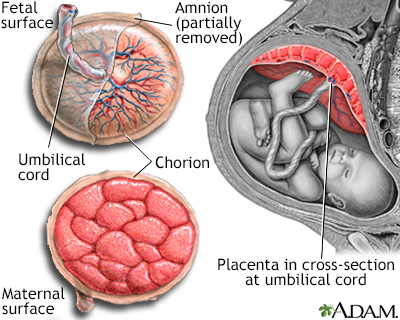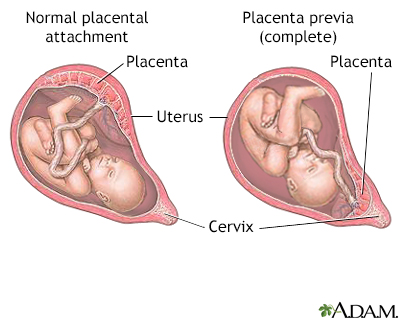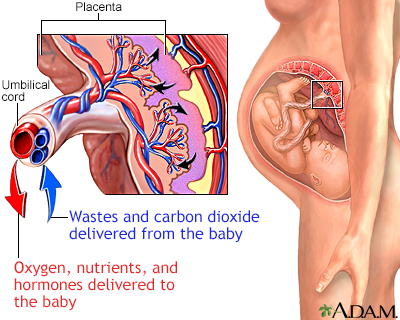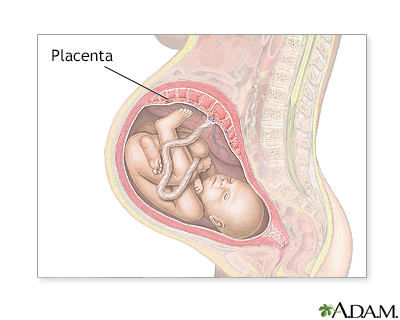Placenta previa
Placenta previa is a problem of pregnancy in which the placenta grows in the lowest part of the womb (uterus) and covers all or part of the opening to the cervix.
Cervix
The cervix is the lower end of the womb (uterus). It is at the top of the vagina. It is about 2. 5 to 3. 5 centimeters (1 to 1. 3 inches) long. Th...

The placenta grows during pregnancy and feeds the developing baby. The cervix is the opening to the birth canal.
Causes
During pregnancy, the placenta moves as the womb stretches and grows. It is very common for the placenta to be low in the womb in early pregnancy. But as the pregnancy continues, the placenta moves to the top of the womb. By the third trimester, the placenta should be near the top of the womb, so the cervix is open for delivery.
Sometimes, the placenta partly or completely covers the cervix. This is called a placenta previa.
There are different forms of placenta previa:
- Marginal: The placenta is next to the cervix but does not cover the opening.
- Partial: The placenta covers part of the cervical opening.
- Complete: The placenta covers all of the cervical opening.
Placenta previa occurs in 1 out of 200 pregnancies. It is more common in women who have:
- An abnormally shaped uterus
- Had many pregnancies in the past
- Had multiple pregnancies, such as twins or triplets
- Scarring on the lining of the uterus due to a history of surgery, C-section, or abortion
- In vitro fertilization
Women who smoke, use cocaine, or have their children at an older age may also have an increased risk.
Symptoms
The main symptom of placenta previa is sudden bleeding from the vagina. Some women also have cramps. The bleeding often starts near the end of the second trimester or beginning of the third trimester.
Sudden bleeding from the vagina
Vaginal bleeding in pregnancy is any discharge of blood from the vagina during pregnancy.

Bleeding may be severe and life threatening. It may stop on its own but can start again days or weeks later.
Labor sometimes starts within several days of the heavy bleeding. Sometimes, bleeding may not occur until after labor starts.
Exams and Tests
Your health care provider can diagnose this condition with a pregnancy ultrasound.
Treatment
C-section - Animation
When it's not possible or safe for a woman to deliver a baby naturally through her vagina, she will need to have her baby delivered surgically, a procedure referred to as cesarean section, or C-section. I know this is a controversial topic recently, sometimes people talk C-sections being done too often. That may be true, but when it is necessary, it can be life saving for mother or baby. A C-section is the delivery of a baby through a surgical opening in the mother's lower belly area, usually around the bikini line. The procedure is most often done while the woman is awake. The body is numbed from the chest to the feet using epidural, or spinal, anesthesia. The surgeon usually makes a cut or incision across the belly just above the pubic area. The surgeon opens the womb, or uterus, and the amniotic sac, then delivers the baby. A woman may have a C-section if there are problems with the baby, such as an abnormal heart rate, abnormal positions of the baby in the womb, developmental problems in the baby, a multiple pregnancy like triplets, or when there are problems with the placenta or umbilical cord. A C-section may be necessary if the mother has medical problems, such as an active genital herpes infection, large uterine fibroids near the cervix, or if she is too weak to deliver due to severe illness. Sometimes a delivery that takes too long, caused by problems like getting the baby's head through the birth canal, or in the instance of a very large baby may make a C-section necessary. Having a C-section is a safe procedure. The rate of complications is very low. However, there are some risks, including infection of the bladder or uterus, injury to the urinary tract, and injury to the baby. A C-section may also cause problems in future pregnancies. The average hospital stay after a C-section is 2 to 4 days, and keep in mind recovery often takes longer than it would from a vaginal birth. Walking after the C-section is important to speed recovery and pain medication may be supplied too as recovery takes place. Most mothers and infants do well after a C-section, and often, a woman who has a C-section may have a vaginal delivery if she gets pregnant again.
Your provider will carefully consider the risk of bleeding against early delivery of your baby. After 36 weeks, delivery of the baby may be the best treatment.
Nearly all women with placenta previa need a C-section. If the placenta covers all or part of the cervix, a vaginal delivery can cause severe bleeding. This can be deadly to both the mother and baby.
C-section
A C-section is the delivery of a baby by making an opening in the mother's lower belly area. It is also called a cesarean delivery.

If the placenta is near or covering part of the cervix, your provider may recommend:
- Reducing your activities
- Bed rest
- Pelvic rest, which means no sex, no tampons, and no douching
Nothing should be placed in the vagina.
You may need to stay in the hospital so your health care team can closely monitor you and your baby.
Other treatments you may receive:
- Blood transfusions
- Medicines to prevent early labor
- Medicines to help pregnancy continue to at least 36 weeks
- Shot of special medicine called Rhogam if your blood type is Rh-negative
- Steroid shots to help the baby's lungs mature
An emergency C-section may be done if the bleeding is heavy and cannot be controlled.
Outlook (Prognosis)
The biggest risk is severe bleeding that can be life threatening to the mother and baby. If you have severe bleeding, your baby may need to be delivered early, before major organs, such as the lungs, have developed.
For most women who receive regular prenatal care, this condition is diagnosed before symptoms appear. This helps the provider and mother take steps to minimize risks from this condition.
When to Contact a Medical Professional
Contact your provider if you have vaginal bleeding during pregnancy. Placenta previa can be dangerous to both you and your baby.
Reviewed By
John D. Jacobson, MD, Department of Obstetrics and Gynecology, Loma Linda University School of Medicine, Loma Linda, CA. Also reviewed by David C. Dugdale, MD, Medical Director, Brenda Conaway, Editorial Director, and the A.D.A.M. Editorial team.
Francois KE, Foley MR. Antepartum and postpartum hemorrhage. In: Landon MB, Galan HL, Jauniaux ERM, et al, eds. Gabbe's Obstetrics: Normal and Problem Pregnancies. 7th ed. Philadelphia, PA: Elsevier; 2021:chap 18.
Hull AD, Resnik R, Silver RM. Placenta previa and accreta, vasa previa, subchorionic hemorrhage, and abruptio placentae. In: Resnik R, Lockwood CJ, Moore TR, Greene MF, Copel JA, Silver RM, eds. Creasy and Resnik's Maternal-Fetal Medicine: Principles and Practice. 8th ed. Philadelphia, PA: Elsevier; 2019:chap 46.
Henn MC, Lall MD. Complications of pregnancy. In: Walls RM, ed. Rosen's Emergency Medicine: Concepts and Clinical Practice. 10th ed. Philadelphia, PA: Elsevier; 2023:chap 173.










 All rights reserved.
All rights reserved.